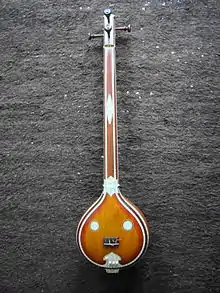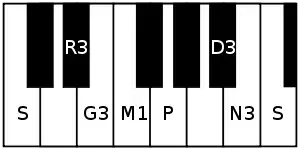| Arohanam | S R₃ G₃ M₁ P D₃ N₃ Ṡ |
|---|---|
| Avarohanam | Ṡ N₃ D₃ P M₁ G₃ R₃ S |
| Carnatic music |
|---|
 |
| Concepts |
| Compositions |
| Instruments |
|
Chalanata (pronounced chalanāta) is a rāgam in Carnatic music (musical scale of South Indian classical music). It is the 36th Melakarta rāgam in the 72 melakarta rāgam system of Carnatic music. It is one of the few rāgams referred by the same name in Muthuswami Dikshitar school of Carnatic music.[1]
Structure and Lakshana

It is the 6th rāgam in the 6th chakra Rutu. The mnemonic name is Rutu-Sha. The mnemonic phrase is sa ru gu ma pa dhu nu.[2] Its ārohaṇa-avarohaṇa structure (ascending and descending scale) is as follows (see swaras in Carnatic music for details on below notation and terms):
- ārohaṇa: S R₃ G₃ M₁ P D₃ N₃ Ṡ[lower-alpha 1]
- avarohaṇa: Ṡ N₃ D₃ P M₁ G₃ R₃ S[lower-alpha 2]
The notes used in this scale are shadjam, shatsruthi rishabham, antara gandharam, shuddha madhyamam, panchamam, shatsruthi dhaivatham and kakali nishadham. As it is a melakarta rāgam, by definition it is a sampurna rāgam (has all seven notes in ascending and descending scale). It is the shuddha madhyamam equivalent of Rasikapriya, which is the 72nd (last) melakarta.
Janya Rāgams
Chalanāta (also pronounced Chalanāttai) has two popular janya rāgams (derived scales) associated with it, namely Nāta (Nāttai) and Ghambheeranāta (Gambheeranāttai). Nāta ragam compositions are sung often in concerts and it overshadows Chalanāta.[3] See List of Janya Rāgams for list of janya rāgams associated with Chalanāta.
Compositions
A few compositions set to Chalanāta are:
- Rājadhirāja (varnam) by Baluswami Dikshitar
- Nagātmajā Manōharam by Dr. M. Balamuralikrishna
- Margazhi Thingal by Andal
- Madhava Panchakam by Oothukkadu Venkata Kavi
- Edayya Gathi by Koteeswara Iyer
Film songs
Language: Tamil
Related rāgams
This section covers the theoretical and scientific aspect of this rāgam.
Chalanata's notes when shifted using Graha bhedam, yields a major Melakarta rāgam Shubhapantuvarali. Graha bhedam is the step taken in keeping the relative note frequencies same, while shifting the shadjam to the next note in the rāgam. For further details and an illustration refer Graha bhedam on Chalanata.